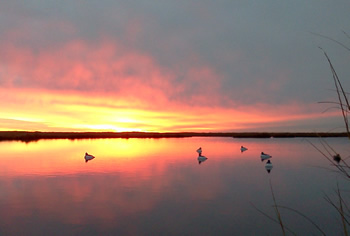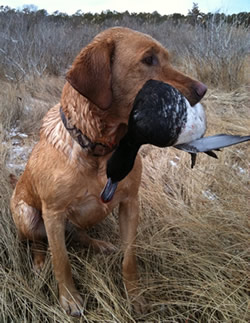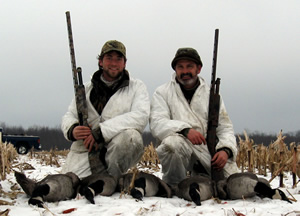2013-2014 Migratory Bird Season
|
||||||||
|
In 2013, the status of ducks and their habitats in mid-continent and eastern North America are sufficient to justify a liberal duck hunting season framework of 60 days with a 6-duck bag limit. New Jersey, along with the other Atlantic Flyway states (Connecticut, Delaware, Florida, Georgia, Maine, Maryland, Massachusetts, New Hampshire, New York, North Carolina, Pennsylvania, Rhode Island, South Carolina, Vermont, Virginia, and West Virginia), has had 60-day duck seasons since 1997.
Each year, the US Fish and Wildlife Service (Service) develops migratory bird hunting regulations after input and consultation with the Atlantic, Mississippi, Central and Pacific Flyway Councils. The Flyway Councils are comprised of representatives from state and provincial wildlife agencies that work with the Service to cooperatively manage North America's migratory bird populations. DUCKS Duck hunting regulations are based on biological population assessments using the Adaptive Harvest Management (AHM) process, which has been developed cooperatively by the Service and Flyway Councils. AHM is an objective, science-based regulation-setting process. During 2013, the AHM process suggested that a liberal duck hunting season in all flyways was consistent with the long-term welfare of North American waterfowl populations. |
In the eastern survey areas, most species of ducks, including mallards, black ducks, and green-winged teal were near to slightly above their long-term averages. Duck species from the mid-continent region including American wigeon, blue-winged teal, gadwall, shovelers, and redheads, were near to well above their respective long-term averages. The canvasback estimate was 787,000 birds which was 37% above the long-term average allowing for an increase in the daily bag limit to 2 birds. Pintails and scaup were each 17% below their respective long-term averages. For scaup, their population level necessitated a reduction in the daily bag limit to 2 birds.
|
This year, the daily bag limit in New Jersey will be 6 ducks and may not include more than 4 mallards (including no more than 2 hens), 4 scoters, 2 scaup, 3 wood ducks, 2 redheads, 2 pintails, 2 canvasbacks, and 1 black duck. The bag limit is 6 ducks for all other duck species. Merganser bag limits will remain at 5 birds per day with no more than 2 hooded mergansers. Merganser bag limits are in addition to regular duck bag limits.
To better serve New Jersey's sportsmen, the Division conducted a survey of duck hunters during the winter of 2012-13. The primary objectives of the survey were to measure the importance of several elements annually considered when setting waterfowl seasons and to determine hunters' preferences for duck season frameworks within each of the state's 3 waterfowl zones. For each of the 3 zones, hunters were presented with 3 choices for a duck season structure and asked to identify which season structure they preferred most. In all zones, one choice was to maintain the recent season structure. For each zone, results were analyzed separately for all respondents as well as for hunters who indicated that they hunted in that particular zone most frequently. Respondents who hunted most frequently in the Coastal Zone preferred, by a 5:4 margin, the option to hunt later into January over options to have 7 or more hunting days in early November. Similarly, the highest proportion (44%) of South Zone hunters, preferred to hunt later into January by taking days from the 1st split in October. |
North Zone duck season preferences were less clear. North Zone duck hunters seemed to prefer to retain at least 2 Saturdays in the 1st split during October by a 5:4 ratio when compared to options to hunt later into January. The ambiguity in North Zone season preferences is probably partially attributable to the recent, frequent changes to the North Zone season structure which has varied in 3 of the last 4 years. Additional information and detailed results can be found in the 2012-2013 Waterfowl Hunter Survey (pdf, 310kb).
Based on the results of this survey, the Coastal Zone duck season will run to the end of the federal framework in late January. In addition, the South Zone duck season will run later into January at the expense of days taken from the first split in October. The North Zone duck season will have a season structure similar to 2012.
CANADA GEESE
The "regular" Canada goose season is based on the status of Atlantic Population (AP) Canada geese which nest on the Ungava Peninsula of northern Quebec. The AP is New Jersey's primary migrant Canada goose population. Immediately preceding the 2013 survey a mechanical problem was discovered on USFWS Kodiak survey planes that could have compromised air-crew safety. The decision was made not to utilize these aircraft which are typically operated in remote northern survey strata and as a result, this survey was not completed. This survey is expected to resume in 2014.
Near Ungava Bay, the timing of snow melt was average while on Hudson Bay, the spring thaw was slightly later than average. A population model that uses spring weather data from the Ungava Bay region to predict breeding conditions, suggested that gosling production in 2013 would be slightly below the long-term average. This population has been relatively stable during the past several years and as a result, the "regular" Canada goose season will remain the same as last year with a 50 day season and 3-bird bag limit.
|
Resident Population (RP) Canada geese are overabundant throughout most of the United States and cause significant damage problems. As a result, additional hunting methods including the use of electronic calls, unplugged shotguns, extended hunting hours, and liberal bag limits are allowed during September hunting seasons. September seasons target RP geese since Atlantic Population or migrant geese do not arrive in New Jersey until October.
Hunters need to remember that these special regulations only apply to the September Canada goose season (September 2-30, 2013). Hunters that choose to use unplugged guns during the September Canada goose season are reminded to reinstall magazine plugs before pursuing other game species. During all other waterfowl seasons, including ducks, brant, regular and winter Canada goose, and light goose, "standard" regulations apply. "Standard" regulations include: electronic calls prohibited, shotguns may not be capable of holding more than 3 shotshells, and hunting hours end at sunset. The Special Winter Canada Goose Season will be held January 27 to February 15, 2014 in two zones with the same hunt area boundaries as last year and a bag limit of 5 Canada geese per day. |
ATLANTIC BRANT
Since Atlantic brant breed in remote wilderness of the Canadian Arctic, their status is measured during January surveys on their Atlantic Flyway coastal wintering grounds. During the 2013 Mid-Winter Waterfowl Survey (MWS), 111,800 brant were counted which was 25% below the 2012 MWS. In addition, observers reported an obvious decline in the abundance of sea lettuce, a primary brant food, during the MWS which was likely attributable to Hurricane Sandy. During most years of the MWS, sea lettuce is observed on sand and mud bars during the ebbing and low tide cycle but it was noticeably scarce this past winter.
Fall surveys during 2012 also indicated that the brant population was only comprised of 7% young birds (18% is average) indicating that they experienced a poor production year. As a result of these indices of population decline, the 2013 brant season was reduced to 30 days with a bag limit of 2 birds. As such, the brant season will be closed during part of the duck season in all zones.
There are 3 primary periods of brant harvest and hunting activity in the Coastal Zone: the first split in early November, Thanksgiving, and the Christmas-New Year's Holiday. As such, it was difficult to decide when to have the brant season closed while the duck season was open under the constraint that the brant season is only 30 days and can only be split into 2 segments. Given these constraints, the brant season cannot cover all 3 of these important hunting periods. After consultation with waterfowl groups and the Fish and Game Council, it was agreed that the brant season should be open for the duration of the first duck season split in November with the balance of the days used during the Christmas-New Year's period and extending into mid-January.
Hunters should check the season dates carefully and note the time periods during the duck season when the brant season is closed. In particular, hunters should note that the brant season is closed during the Thanksgiving Holiday period in the Coastal Zone.
LIGHT GEESE
"Light" goose (greater and lesser snow geese as well as Ross's geese are collectively referred to as "light" geese) populations remain high and biologists are concerned about the impacts light geese have on fragile Arctic nesting habitats. Serious damage to Arctic wetlands has already been documented in several key light goose breeding colonies. This damage impacts the light geese themselves, as well as other wildlife dependent on the Arctic ecosystem. Serious damage to agriculture also occurs in migration and wintering areas. As a result of this overabundance issue, the Service will again authorize implementation of a Conservation Order (CO).
A CO is a special management action, authorized by the Migratory Bird Treaty Act that is needed to control certain wildlife populations when traditional management programs are unsuccessful in preventing overabundance of that population. The CO allows an extended time period outside of traditional hunting seasons as well as additional methods for taking light geese without bag limits. The intent of the CO is to reduce and/or stabilize North American light goose populations that are above population objectives.
In the Atlantic Flyway, greater snow geese are the most abundant light goose population. The preliminary estimate from 2013 spring surveys was 921,000 birds which is nearly twice the size of the population objective of 500,000 birds. As a result, the hunting season length for light geese will be the maximum allowed under the Migratory Bird Treaty Act (107 days) with liberal bag limits of 25 light geese per day with no possession limit.
In addition, a CO will be implemented in the spring of 2014 from February 16 to April 5. During the CO, special regulations will be allowed including the use of electronic calls, shotguns capable of holding up to 7 shells, extended shooting hours, and no bag limits. Hunters interested in participating in the CO should check the migratory bird regulations and/or the Division's web site for more details on obtaining required permits and hunting activity reporting requirements.
ADDITIONAL INFORMATION
Since 1997, the Service has allowed states to hold Youth Waterfowl Hunting Days on weekends, holidays, or other non-school days when youth hunters would have an opportunity to participate. Youth Days are held when waterfowl seasons are closed to the general hunting public. The objective of Youth Days is to introduce young hunters to the concepts of ethical use and stewardship of waterfowl, encourage youngsters and adults to experience the outdoors together, and to contribute to the long-term conservation of the migratory bird resource.
Youth Days are a unique educational opportunity, above and beyond the regular season, which helps ensure high-quality learning experiences for youth interested in hunting. Atlantic Flyway states are permitted to hold two Youth Days in each zone. New Jersey Youth Waterfowl Hunting Days will be October 5 and November 2 in the North Zone; October 12 and November 9 in the South Zone and October 26 and November 16 in the Coastal Zone.
All hunters pursuing migratory birds including ducks, geese, brant, coot, woodcock, rails, snipe or gallinules, are reminded to obtain a Harvest Information Program (HIP) certification. The process is the same as in 2012. Migratory bird hunters can get their HIP certification one of three ways: online by visiting the Division's license sales web site, at any license agent, or by calling the toll-free NJ telephone sales line at 888-277-2015.
Additional information on the 2013 status of waterfowl and habitat conditions, as well as accompanying status videos, can be found at https://www.fws.gov/birds/management/flyways.php.
The 2013-14 New Jersey migratory bird hunting season dates follow. The 2013-14 Migratory Bird Regulations publication is available through the link below and paper copies will be available at Division offices, license agents, and sporting goods stores in late summer.
2013-2014 Migratory Bird Regulations Booklet (pdf, 165kb)
The division wishes all migratory bird hunters a safe and enjoyable hunting season.
2013-2014 Migratory Bird Seasons Summary (pdf, 18kb)
Harvest Information Program (HIP) Certification Information
|
||
|
|
||
|
||
| |
||



